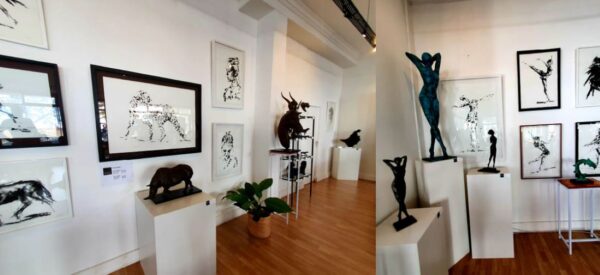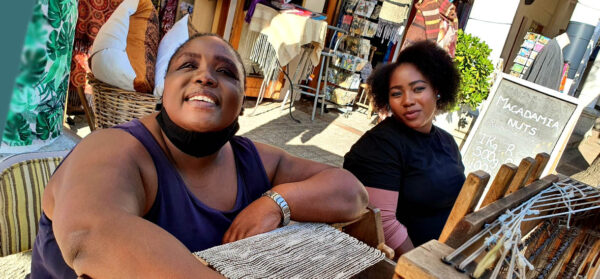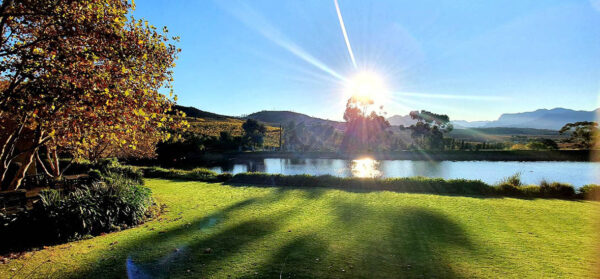Stellenbosch, about 50km from Cape Town, is one of the country’s oldest wine growing regions. It is also the creative Mecca for thought-leaders, who craft and design in a way that changes the world. It’s festooned with art galleries, exhibiting themes covering South Africa’s landscape, indigenous people, and social commentary, in mediums from Realism to Abstract. Johan Nepgen, my Stellenbosch On Foot guide, walks me around this gorgeous oak tree draped town, introducing me to artists like bronze sculptor, Stephen Rautenbach, who’s studio (housed in a historic building) is an intimate affair, cluttered with beautiful and unusual sculptures. His inspiration is derived from nature, stories, literature, mythology, and rhyme, and thrown into the mix is classical portraiture and the rare classical nude.
Johan Nepgen, my Stellenbosch On Foot guide, walks me around this gorgeous oak tree draped town, introducing me to artists like bronze sculptor, Stephen Rautenbach, who’s studio (housed in a historic building) is an intimate affair, cluttered with beautiful and unusual sculptures. His inspiration is derived from nature, stories, literature, mythology, and rhyme, and thrown into the mix is classical portraiture and the rare classical nude.
Numerous fine art galleries – Art on Church, for instance, are heaving with unimaginable talent. Like wildlife artist, Alan Ainslie, who captures the characteristics of a wild animal in a three-dimensional form – suspending his sculptures by cantilevering them, freeing them from their bases. And contemporary artist Vincent da Silva, who’s impaso sculpting style brings texture and a sense of movement to his bronzes.

On the sidewalk, outside an elegant boutique named ‘African Silks’ two ladies are spinning a scarf from silk. Nokwakla Ndlangalavu and Vuyokadi Foca speak of their silks and how it’s cultivated on silk farms in Mpumalanga, supporting unemployed women. “To make this scarf needs around 3,000 Mopani month silk pods – and plenty of time!” announces Nokwakla proudly.
 Discovering art in the most unlikely of places.
Discovering art in the most unlikely of places.
I’m at Amazink, South Africa’s first township theatre-restaurant, lunching on traditional spicy chicken (think Nando’s, but better) and pap (maizemeal), served in a cardboard box. With me is Paul Roviss Khambue, social entrepreneur and champion of Kayamandi, a suburb on the outskirts of Stellenbosch.
Paul’s a softly spoken, gentle man, who speaks of the early 1950s when, as part of increased segregation under the apartheid government, Kayamandi was created. It was originally built to exclusively house black migrant male laborers employed on the farms in the area.
“Although apartheid ended +30 years ago, its aftermath is still evident as the youth suffer the consequences which deny them progress. We need to confront and address the past, acknowledge it, talk about it, forgive it, and move forward, walking the road together,” says Paul.
 His solution is to showcase and applaud life in the townships surrounding Stellenbosch through the medium of Sport and Performing Arts. “This creates opportunities for the youth”, says Paul, “discovering talent and giving them a platform from which to grow.”
His solution is to showcase and applaud life in the townships surrounding Stellenbosch through the medium of Sport and Performing Arts. “This creates opportunities for the youth”, says Paul, “discovering talent and giving them a platform from which to grow.”
Paul speaks of the role that Amazink plays in this. “This is the place where the community comes together to celebrate performing arts – Gembe drumming, poetry, theatre, and choral music – the type made famous by Ladysmith Black Mambazo, the internationally known South African male singing group.”
Kayamandi has traditionally been considered by tour operators as off limits, secreted away on the outskirts of a prosperous wine-town. A no-go zone some mistakenly presumed dangerous. But that’s not the case at all – in fact, that assumption is dead wrong as the locals welcome visitors into the community.
Whilst eating dessert (ice lollies), Paul continues: “Here in Kayamandi we have fruit and vegetable corner shops, hairdressers, barbers, tailors, mechanics, street food vendors, township guides, local ladies who host lunches in their dining rooms, preparing local food, telling their guests stories about life in the township. Some even offer home-stay experiences – should their visitors want to live traditionally, hear the township noises, meet the colourful characters, experience the ripeness of it all, the togetherness.”
These are not the words I would have associated with a township where the homes are still mostly shacks and the poverty is immediately visible. But true they are as wherever I walk, I am greeted and smiled at – kids striking a pose for the camera, ladies hanging over their kitchen stable door’s shouting a welcome and giving a wave.
As if on cue, Leletho Zulu, a performer and drummer of note, begins singing a tribal song of forgiveness and hope.
Since the early 1600s Stellenbosch is known as the centre of South Africa’s wine industry.
At the Cellar Door, a deli-style restaurant on the 164-hectare Jordan Wine Estate, I’m sitting under a giant oak tree. Golden shafts of light cascade through the branches which hang heavy with autumnal leaves. A sun kissed vineyard stretches before me, as does the long day, described by Jeanneret Momberg, CEO of Visit Stellenbosch.
I’m getting ready to have my ideas of a tasting redefined and head off on a ‘wine safari’. The estates Thea van der Merwe takes the wheel of a 4×4 open safari-type Land Rover. We bounce up a steep dirt track, finding suitable vantage points to take in the spectacular 360° tasting experience – one overlooking False Bay, and another Table Bay (and Table Mountain).
When the corks pop, Thea speaks of why the Jordan terroir is unique by nature’s design. When I introduced ‘Nine Yards’ to my lips, I stopped listening, as I could totally get what Sir Richard Branson meant when he proclaimed their Chardonnay (which they were yet to find a suitable name for) as them having gone “the whole Nine Yards”.
 Sleep
Sleep
The Lanzerac Wine Estate, on the outskirts of Stellenbosch, is a historic landmark – a Cape Dutch icon. Shaded by giant Oak trees, its five-star manor house hotel surrounded by dramatic mountains, and countless rows of ancient vineyards. The estate’s cellar and outbuildings have been converted into bars, lounges, dining areas, and hotel rooms.
With 330 years behind its name, this Stellenbosch landmark oozes old-world charm. Think boutique, antique, and unique. This super chic heritage property is the place to be seen and is a destination in its own right.
I enter the estate down a long Oak-lined driveway, and could almost feel time slow down, and history settling in around me. Every hotel has a barman, a doorman, or a concierge – keepers of secrets – who all came out in force. One parked my Jaguar, a second whisked my luggage away, and yet another led me to the reception with the promise of a cold drink.
Luxury has become a much over-used word because extravagance always needs to outdo itself, which my opulent suite did. A blend of understated grandeur and modern amenities. Sumptuous opulence personified.
 I met a few girlfriends for dinner in The Taphuis – one of the hotel’s dining options – a country-inspired gourmet pub, complete with a roaring fireplace, rich texture, rough stone walls, brick floors and exposed wooden ceilings. On the menu everything is, of course, zero miles travelled.
I met a few girlfriends for dinner in The Taphuis – one of the hotel’s dining options – a country-inspired gourmet pub, complete with a roaring fireplace, rich texture, rough stone walls, brick floors and exposed wooden ceilings. On the menu everything is, of course, zero miles travelled.
Explore more at South African Tourism https://www.facebook.com/southafrica.uk/

